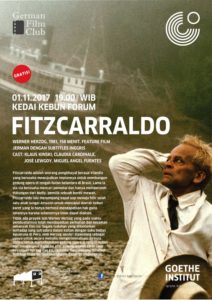

German Film Club
Cooperation between Kedai Kebun Forum (KKF) and Goethe Institut Jakarta
Wednesday, 1 November 2017, 7.00 pm
Auditorium, Kedai Kebun Forum (KKF)
Jl. Tirtodipuran 3, Yogyakarta
Open for public and free
presents
-a legendary surreal adventure-drama by werner herzog located in the brazilian rainforest. This film is also to welcome the opening agenda of Biennale Jogja XIV on November 2 with Brazil as the guest country-
FITZCARRALDO
Director: Werner Herzog, 1981, feature film, 158 minutes, German with English subtitles
Cast: Klaus Kinski, Claudia Cardinale, José Lewgoy, Miguel Angel Fuentes, Paul Hittscher
SYNOPSIS
Fitzcarraldo, an eccentric by the name of Brian Sweeney Fitzcarraldo, is a monomaniacal dreamer, with a bold dream, the dream of creating his own opera in the jungle. The nouveau riche millionnaires in the Amazon region show an arrogant lack of understanding for his gramophone music, but the poor children in Iquitos love him and his music; for a long time he had sought in vain to find someone to finance his project and h only received support from Molly, the owner of a high-class brothel. Now Fitzcarraldo takes a steamship up a tributary of the Amazon, in order to reach the rubber region, which is actually inaccessible, the only reason why he was given the rights to use the land. The profits are to help finance his dream of a jungle opera.
As Fitzcarraldo, abandoned by most of his crew, gets into an almost hopeless situation in an untouched region inhabited by the native Indians, Caruso’s arias echoing in the jungle fascinate and placate them. They view the ship as a mythical object, supposed to help rid them of the curse that lies over the land. They thus support Fitzcarraldo and his basically absurd project. Since the river, which would lead directly to the rubber region, has become impassable due to violent currents, the dreamer tries to get there via another tributary of the Amazon — yet to do so the ship first has to be transported over a mountain. After many trials and tribulations he succeeds, but objectively, the undertaking ends in a catastrophe. Fitzcarraldo is once again financially ruined – but he turns the failure into triumph and in his own way realizes his dream of a great opera in the Amazon jungle in Iquitos.
The film begins with a fictional appearance by Enrico Caruso in the real opera house at Manaus, which was built shortly before the turn of the century in the jungle — at the time of the great rubber boom. Caruso’s voice, ringing forth from records, is present throughout the entire film.
No other project of Werner Herzog’s has ever attracted as much attention and animosity during its making as this film; all the charges levelled at him in connection with the Aguaruna Indios of Peru were in his view an attempt to methodically criminalize him. Added to this were the reports and rumours about accidents and catastrophes during the shooting; there’s no trace of this in the final film, there is not one scene, that could be interpreted as showing off how difficult it was to make. Herzog tells his story in a calm and easy manner rare in his other films. He is less strained in his search for visual attractions and unprecedented images (one of his visual goals!) than one might expect after the leadup to the film. This is not even the impression in those scenes which make up the climax of the story — when the stately steamer is actually transported over the mountain. One sees the ship inching its way up the mountain, an endlessly arduous task interrupted by a multitude of setbacks, in particular due to the winches driven by the muscle power of the Indios, supported by the power of the ship’s steam engine, with which the anchor cable, fixed to a hillock, is taken in. The pictures look like they have been taken from a dream. The jungle the steamship moves through also forms part of the dream landscape and the dream of overcoming gravity is at the centre of the film. “Only dreamers move mountains,” Herzog has his hero declare in a very humiliating situation – it becomes evident how much the director identifies with his hero: the obsessive dream of building an opera house in the jungle and the ship on the mountain is something Herzog has in common with Fitzcarraldo, otherwise he could never have made the film.
Fitzcarraldo and Herzog – both can be seen as ambivalent characters, as egomaniacal artists or as children unwavering in their playfulness.
Significantly, the belief in the magic of music is what saves the adventurer Fitzcarraldo in the moment of danger. “Bad people don’t have songs,” according to a German saying, and so Fitzcarraldo has an enormous gramophone fixed to the upper deck of the ship, from which the radiant voice of Caruso rings out above the surface noise and which is an aid in the first cautious encounter with the Indios. Fitzcarraldo’s attempts to greet them with a handshake turns into a tentative, almost magical touching of fingertips.
Fitzcarraldo sets out upstream; at the end he returns from another direction, defying the natural laws of the river. With this form of homecoming a circle is closed — in Herzog’s films a recurrent motif of futility, in which great endeavours end at their point of departure. Fitzcarraldo celebrates the triumph of his imagination and suffers economic ruin, both experiences familiar to a German filmmaker. This adventure unmistakably belongs to the world of Werner Herzog, who once said, “One failure is better than none.”
For more info please contact Uniph +6285725809139